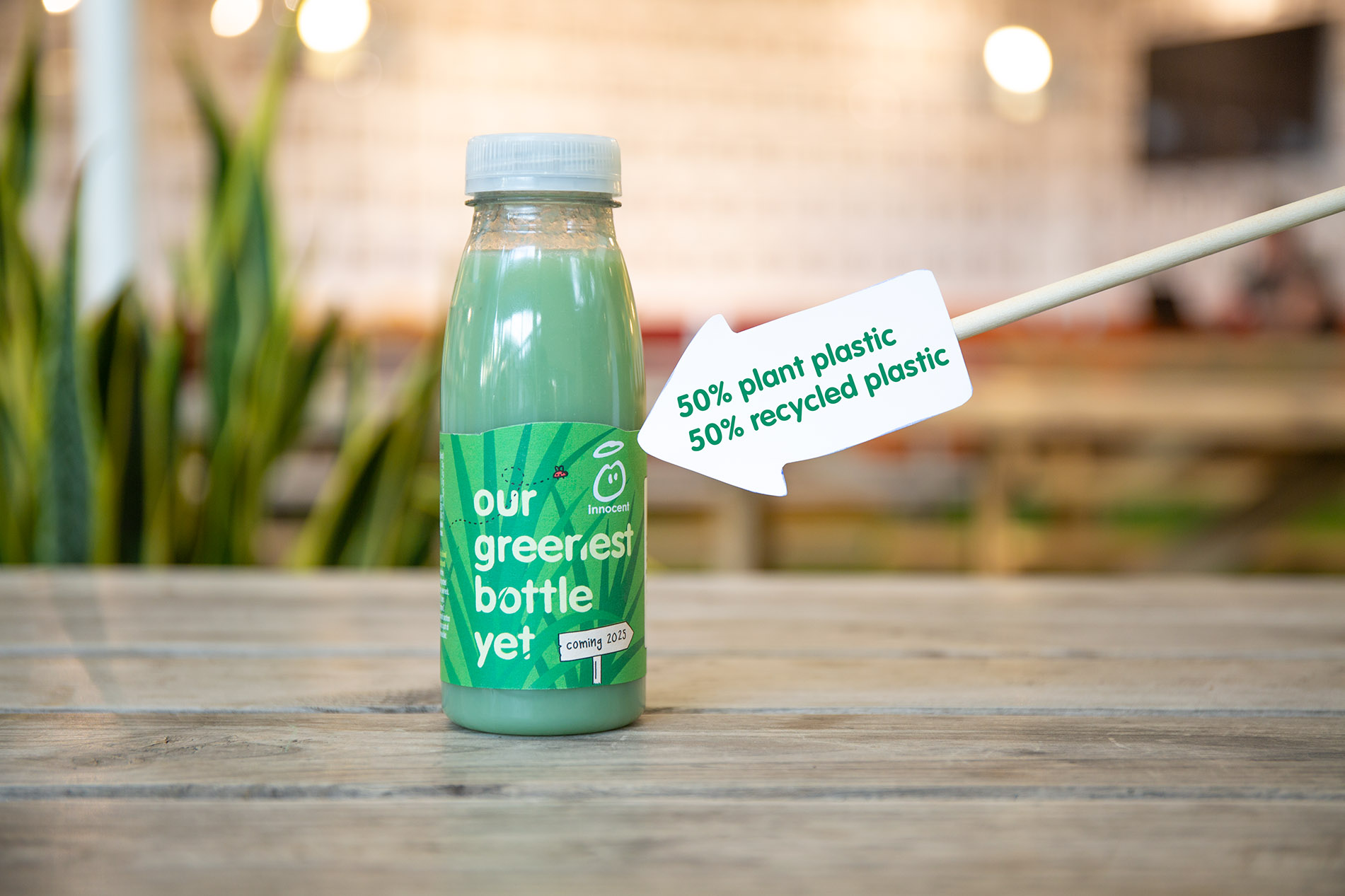We're using plant feedstock (from sugar cane and corn) to create PET plastic that's exactly the same as the PET plastic made from oil, but is much kinder to the environment. Using a renewable source like plants means we don't need to use fossil sources, which are a finite resource.
green bottle
our greenest bottle yet
If you've ever had a cocktail in a coconut then you'll know all about the joys of drinking out of plants. Now, imagine that experience but with a less hairy receptacle that also recycles old bottles.

We’ve made a prototype of a shiny
new bottle made from:
0% virgin oil-based plastic, 50% plant plastic and 50% recycled plastic.
Yep, that's right. We’re not just using plants to make the drink, they're now making up part of the bottle too. That’s growth. Literally. And, to top it all off, it’s 100% recyclable. Crushed it. Or, at least, the recycling plant will if you pop it in the right bin.
Over the years, we've chopped and changed our packaging more times than a teenager's haircut and experimented with everything from 100% recycled plastic to "compostable bio materials". We've learnt that when it comes to sustainability, there's no silver bullet. Good news for werewolves, but tougher news for nature. Our packaging is a big part of our big dream to look after nature like she looks after us, so people and the planet can thrive together. Our future bottle is just one way we’re working towards make our big climate ambitions come true - it slices a chunk off our carbon footprint, eliminates the use of virgin fossil materials, and thanks to its recyclability, turns old bottles into new ones. Told you it was fancy.
Ironing out all the kinks in something as new-fangled as this takes a while, but we reckon it should be in fridges across the land come 2025. We're hoping that by sharing the prototype nice and early we can get feedback on it while getting other companies onboard too. Win win.
got a burning question?
Both the plant plastic and recycled plastic are fantastic materials, but we believe combining them together is the most sustainable solution for the long term. If you make a 100% plant plastic bottle, the material all comes from a renewable source which is really good, but with no recycled content it won't use up any of the material that's already been produced.
If you make a 100% recycled plastic bottle, you can only recycle it about ten times because the quality degrades and there are some losses. To allow the material to be reprocessed in the recycling system you need to add some high- quality plastic so the recycled material produced can be used and recycled again.
By using half of each we tackle both of these problems with one bottle. The new plastic from plants comes from a good place and introduces high quality material into the recycling system - the recycled plastic reuses old bottles.
Our approach to packaging is guided by the principles of the circular economy to move away from finite resources like oil and towards a world where everything gets reused, recycled or composted. As signatories to the UK and French Plastics Pacts and the Ellen MacArthur Foundation global commitment on plastics we are able to access the latest thinking and learn from others to keep evolving in line with science and innovation.
Plastic is much lighter and easier to transport, plus there is no risk of shattering which is important for a product people carry around with them. Our research has shown that single use plastic bottles have a 3 times lower carbon footprint than single use glass, even more so if the material is recycled. If we were to move to glass packaging, we would have to double the number of trucks we use (because the bottles are so heavy). Using recyclable plastics, combined with our commitment to transport by road and sea wherever possible, means we are significantly reducing our carbon emissions.
The plant plastic is a brand new material, and right now we're using it to create our prototype bottles. We're aiming to include it in more of our bottles when It Is available In bigger quantities.
We’re committed to ensuring all our bottles are recyclable and to making it as easy as possible for our drinkers to recycle them with an ambition to collect and recycle 70% of our bottles by 2023. We do this through education and awareness, lobbying for better recycling infrastructure and deposit return schemes (DRS) which are shown to drive recycling rates of over 90%. We were proud to see a national DRS scheme we campaigned for in Germany has just become law (May 2021).
We’re also thinking about how we can reduce the total amount of packaging we need for our little drinks and are working to make our packaging lighter, saving 2,500 tonnes of plastic between 2020 and 2023. This includes making our bottles lighter, removing tampers, switching glues and making our labels smaller.
This was an issue with biofuels, so the Industry Is working hard to make sure It doesn't happen again. The Bioplastics Feedstock Alliance (BFA) has been formed by a number of brands and is guided by WWF. It's using science to make sure plant plastics are produced In a way that protects the environments - you can read about It here: http://bioplasticfeedstockalliance.org/ .

Or maybe one at a normal temperature? We've answered a few of the most common questions here.
